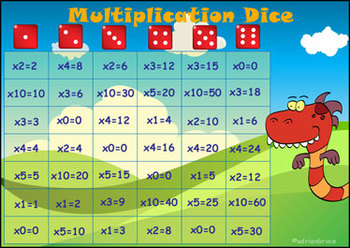

'Multiplication Game'- A dice based multiplication game which is an ideal way to add a little variety to multiplication practice. It is currently one of my most downloaded games.
What You Need:
2 Players
1 Game Board
Counters of One Color
Counters of Another Color
1 die (1-6)
How to Play:
1. The person who last ate bacon goes first.
2. Player 1 rolls the die then chooses to answer an algorithm from the column the die indicates i.e. If a 6 is thrown then they can answer any algorithm in the sixth column.
3. Player One then states the answer aloud and places a counter over the algorithm.
4. Player 2 then repeats steps 2 and 3.
5. Play continues in this fashion until one of the players wins by getting 4 counters in a row either horizontally, vertically or diagonally.
Board 2 Variation – Players throw the die to indicate which column to choose an algorithm from. Players then multiply the die at the top of the column but the number where they want to place their counter. They then answer the algorithm produced aloud & place their counter over it.
Tips and Tricks:
- It is a good idea for players to checked their opponent’s calculations to avoid cheating ;)
- When starting out playing this game have the students use a calculator to familiarise themselves with the algorithms used.
- Play one game with a calculator and one game without.
Before the Game:
- Explore strategies for using the calculator as a means of guess and check. Eg input the algorithm then pause for a moment and guess or work out the answer. What might be the next step?
- If a ‘need to work on’ list has been made from previously playing this game, have the students list some achievable goals e.g. today I will master 6x10, 10x6, 5x4 and 4x5.
During the Game:
- Help the students use the calculator as a tool for learning as opposed to a crutch to lean on.
- Have students record a list algorithms they have identified through playing the game they ‘need to work on’.
After the Game:
- Reflect on how tempting it is to just let the calculator do the work.
- Discuss personal feelings around using the calculator as a learning tool.
- Have students reflect on weather or not their goals were achieved / were realistic / not challenging enough.
- When students write their next goals they need to consider their answers to the above questions.
- What strategies have you discovered that help you do well in this game?
What You Need:
2 Players
1 Game Board
Counters of One Color
Counters of Another Color
1 die (1-6)
How to Play:
1. The person who last ate bacon goes first.
2. Player 1 rolls the die then chooses to answer an algorithm from the column the die indicates i.e. If a 6 is thrown then they can answer any algorithm in the sixth column.
3. Player One then states the answer aloud and places a counter over the algorithm.
4. Player 2 then repeats steps 2 and 3.
5. Play continues in this fashion until one of the players wins by getting 4 counters in a row either horizontally, vertically or diagonally.
Board 2 Variation – Players throw the die to indicate which column to choose an algorithm from. Players then multiply the die at the top of the column but the number where they want to place their counter. They then answer the algorithm produced aloud & place their counter over it.
Tips and Tricks:
- It is a good idea for players to checked their opponent’s calculations to avoid cheating ;)
- When starting out playing this game have the students use a calculator to familiarise themselves with the algorithms used.
- Play one game with a calculator and one game without.
Before the Game:
- Explore strategies for using the calculator as a means of guess and check. Eg input the algorithm then pause for a moment and guess or work out the answer. What might be the next step?
- If a ‘need to work on’ list has been made from previously playing this game, have the students list some achievable goals e.g. today I will master 6x10, 10x6, 5x4 and 4x5.
During the Game:
- Help the students use the calculator as a tool for learning as opposed to a crutch to lean on.
- Have students record a list algorithms they have identified through playing the game they ‘need to work on’.
After the Game:
- Reflect on how tempting it is to just let the calculator do the work.
- Discuss personal feelings around using the calculator as a learning tool.
- Have students reflect on weather or not their goals were achieved / were realistic / not challenging enough.
- When students write their next goals they need to consider their answers to the above questions.
- What strategies have you discovered that help you do well in this game?
Something went wrong, please try again later.
I look forward to using these games to reinforce student's recall of times tables facts. Thank you.
Report this resourceto let us know if it violates our terms and conditions.
Our customer service team will review your report and will be in touch.
£2.65